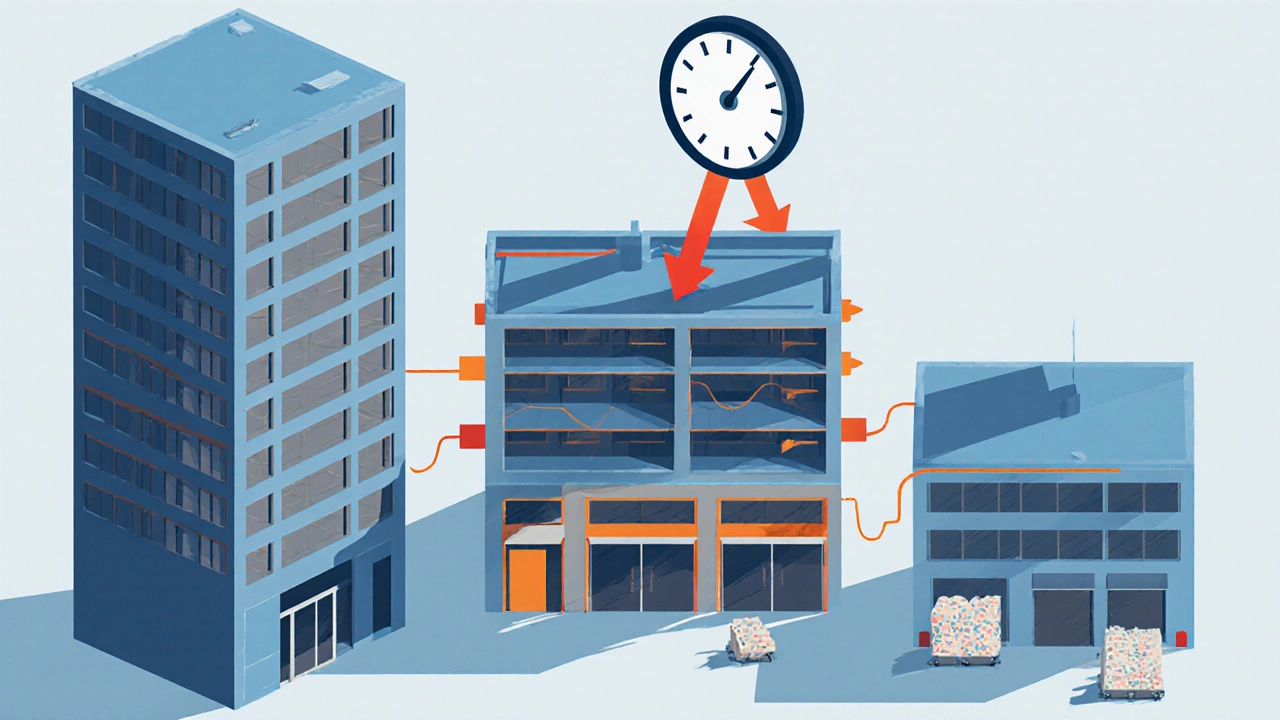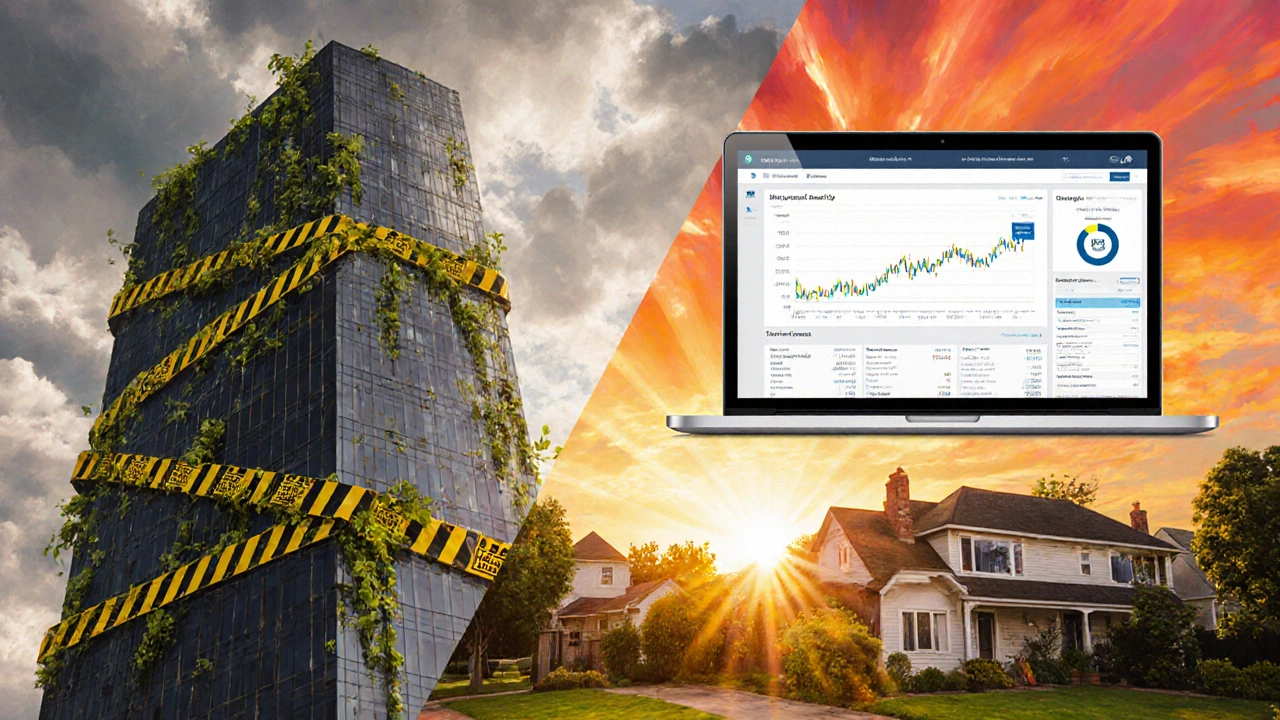Why Not to Invest in Commercial Real Estate? Risks You Should Know

Commercial Real Estate Risk Calculator
Thinking about throwing money at a big office building or a sprawling warehouse? Before you sign the lease on a deal, consider the hidden pitfalls that can turn a promising commercial real estate investment into a costly lesson.
Key Takeaways
- Commercial properties are far less liquid than residential assets, making quick exits difficult.
- Vacancy rates and tenant turnover can spike unexpectedly, choking cash flow.
- Financing costs rise quickly when interest rates climb, eroding returns.
- Management complexity and regulatory compliance add hidden overhead.
- Alternative assets often deliver higher risk‑adjusted returns with far less hassle.
Understanding Commercial Real Estate
Commercial Real Estate is a category of property used for business purposes, including office buildings, retail centers, industrial warehouses, and mixed‑use developments. It differs from residential real estate in size, tenant mix, and financing structures.
Within the broader world of Real Estate Investment the practice of allocating capital to purchase, develop, or manage property for income and appreciation, commercial assets often promise higher yields-yet that premium comes with a suite of risks that many first‑time investors overlook.
Liquidity: The Biggest Hidden Cost
Unlike a single‑family home that can sell in weeks, a commercial building may sit on the market for months or even years. The pool of qualified buyers is smaller, and transactions involve complex due diligence, financing contingencies, and often, zoning approvals.
This lack of market liquidity means you could be stuck holding a property during an economic downturn, forced to lower rent or sell at a loss. For investors who need flexibility, the illiquid nature of CRE can be a deal‑breaker.
Tenant Risk and Vacancy
Commercial leases are typically longer-five to ten years-so a single tenant walking out can create a sizable cash‑flow gap. Even with longer leases, the Tenant Turnover the frequency with which occupants leave a property, prompting vacancy and re‑leasing costs can be higher than expected in sectors like retail, where consumer trends shift rapidly.
Office space, for instance, faced a wave of remote‑work adoption after 2020, slashing demand for traditional cubicle farms. Retail properties have contended with e‑commerce cannibalizing foot traffic, leading to higher vacancy rates in many malls.
Financing and Interest‑Rate Exposure
Commercial loans carry larger amounts and stricter covenants than residential mortgages. When the Interest Rates the cost of borrowing money, expressed as an annual percentage of the loan balance rise, debt service can quickly outpace rental income.
Even a modest 1% increase can shave 0.5%-1% off your net operating income (NOI), turning a projected 8% cap rate into a marginal 6%‑7% after debt service. In a rising‑rate environment, many investors find themselves over‑leveraged.

Understanding Cap Rates and Returns
The Cap Rate short for capitalization rate, it measures the expected return on a property based on NOI divided by purchase price is the go‑to metric for evaluating CRE deals. While a high cap rate looks attractive, it often signals higher perceived risk-think older buildings, sub‑prime locations, or unstable tenants.
Chasing high cap rates can trap you in properties that demand extensive renovations, higher maintenance costs, and more active management, eroding the very return the cap rate promised.
Management Complexity and Hidden Costs
Owning a warehouse or a multi‑tenant office tower is not a set‑and‑forget venture. You’ll need to handle:
- Maintenance of large HVAC, roof, and structural systems.
- Compliance with commercial building codes, fire safety, and ADA requirements.
- Negotiating and enforcing lease terms, security deposits, and rent escalations.
- Hiring or contracting professional Property Management services that oversee day‑to‑day operations, tenant relations, and maintenance for commercial assets.
These responsibilities translate into higher operating expenses and often require hiring specialists, adding to the overall cost structure.
Regulatory and Tax Nuances
Commercial properties fall under stricter zoning, environmental, and reporting regulations. An unexpected environmental assessment-or a change in zoning law-can stall a project and bring unexpected fines.
On the tax side, while you can claim depreciation, recent changes to the 179 deduction and bonus depreciation rules have reduced some of the historic tax shelters that made CRE appealing.
Economic Cycle Sensitivity
Commercial real estate is tightly linked to the broader Economic Cycle the recurring pattern of expansion, peak, contraction, and trough that economies experience over time. During a recession, businesses cut office space, retailers scale back, and industrial demand can swing with supply‑chain disruptions.
Because cash flow depends on tenant health, a downturn can quickly turn a stable income stream into a series of missed payments.
Market Liquidity and Exit Strategies
Disposing of a commercial property often requires a broker, a marketing campaign, and a buyer pool that may be limited to institutional investors or REITs. The longer the hold period, the higher the carrying costs, which eat into any eventual profit.
Many investors underestimate the time and expense needed to execute an exit, only to discover that the market for a specific asset type-say, a suburban strip mall-has dried up.

Alternative Investments Offer Better Risk‑Adjusted Returns
If you’re after steady cash flow without the headaches, consider alternatives such as:
- Dividend‑paying stocks in the REIT sector, which provide liquidity and lower minimum investment.
- Real Estate Crowdfunding platforms that let you own a slice of a large property with minimal management responsibility.
- Direct residential rentals in high‑growth neighborhoods, which tend to be easier to lease and sell.
These options often deliver comparable yields with far less capital outlay, lower leverage, and a much quicker exit path.
Quick Checklist Before You Commit
- Assess your tolerance for illiquidity and long hold periods.
- Run a stress test on cash flow against a 2% rise in interest rates.
- Calculate the true cap rate after accounting for expected vacancy and management fees.
- Review zoning and environmental reports for hidden compliance costs.
- Consider diversifying with more liquid real‑estate assets or REITs.
Comparison of Common Commercial Property Types
| Property Type | Typical Lease Length | Vacancy Sensitivity | Management Intensity | Liquidity Rating |
|---|---|---|---|---|
| Office Space | 5‑10 years | High (remote‑work shifts) | Medium‑High | Low |
| Retail Property | 3‑7 years | Very High (e‑commerce impact) | High | Low‑Medium |
| Industrial Warehouse | 5‑15 years | Medium (supply‑chain trends) | Medium | Medium |
| Mixed‑Use | Varies | Medium‑Low (diversified tenants) | High | Medium‑High |
Final Thought
Commercial real estate can still be a solid part of a diversified portfolio, but it isn’t the easy‑money shortcut many headlines suggest. Weigh the liquidity constraints, tenant risk, financing exposure, and management burden against the potential upside. If those drawbacks line up with your risk appetite, proceed with caution; otherwise, explore the smoother avenues listed above.
Frequently Asked Questions
What is a good cap rate for commercial property?
A "good" cap rate depends on location, asset class, and market conditions. In stable markets, 6%‑7% is common; higher rates often signal higher risk or poorer tenant quality.
How long does it typically take to sell a commercial building?
Selling times vary widely, but on average a commercial property stays on the market 6‑12 months. Prime assets in major metros can move faster, while niche properties may linger over a year.
Can I finance a commercial property with a residential mortgage?
Usually not. Lenders treat commercial assets as higher‑risk loans, requiring separate commercial mortgage products with stricter underwriting and higher down payments.
Is tenant turnover more costly in retail than in office space?
Retail often incurs higher turnover costs because landlords may need to invest in store‑front build‑outs, signage, and marketing to attract new tenants, whereas office spaces generally require less fit‑out work.
What alternatives offer similar yields with lower risk?
Dividend‑paying REITs, real‑estate crowdfunding, and high‑quality residential rentals typically provide comparable cash flow but with greater liquidity and less management hassle.









Write a comment